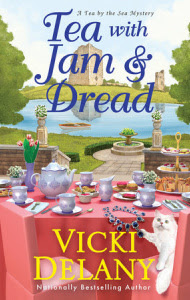 |
| A part of Jefferson's orchard |
There are cookbooks from Monticello. In fact, Thomas Jefferson himself left some handwritten recipes, which have been published. I don’t have that cookbook (although I may need to get it!), and I wouldn’t presume to borrow such recipes without attribution. However, I do have a copy of The Williamsburg Art of Cookery that my grandmother purchased in 1951, which draws upon a range of 18th and early 19th century recipes, as originally written, so I present you with one of those recipes, A Pupton of Apples, originally written by Mrs. Martha Bradley. Apparently she was an important figure in 18th-century cookery. I thought I’d try it, in honor of Johnny and Meg and Seth.
A Pupton of Apples
MY FIRST BATTLE OF PUPTON:
 |
| These are Cortlands, if you're curious |
18 apples, peeled, cored and quartered
Okay, how big was an apple in 1800? Eighteen apples is a lot. I used nine.
3 Tblsp water
5 oz. sugar (by weight)
1/2 tsp cinnamon
Breadcrumbs
Hello? You mind telling me how much? A tablespoon? A pound?
1/4 lb (1 stick) butter, softened
6 egg yolks
Put the apple quarters in a saucepan and add the water and sugar. Set over low heat and cook, stirring occasionally. When they are tender, add the cinnamon. Transfer to a large bowl and cool—the mixture will thicken. Um, are these supposed to be reduced to mush or still lumpy? Do I mash them or just go with the way they are? Please explain!
Take some grated breadcrumbs. As I said above: HOW MUCH??? I decided that two cups seemed reasonable. I made my own breadcrumbs from some artisanal (white) bread. Nobody mentioned whether they should be fresh or dry.
Beat the six egg yolks and blend with the butter. Add the breadcrumbs.
Combine this mixture with the cooled apples. And you get (tada!) a pile of lumpy mush.
Put the mixture into a baking dish. Will someone please explain what an 1800 baking dish is? China or metal? Deep or shallow? How well filled should it be?
Preheat the oven to “slow”. I would guess 350 degrees. Bake for half an hour.
When it is done, turn it out onto a dish and serve hot. Uh, about that “turn out” part—yes, it came out of my (metal) baking dish. Or at least, most of it did. It sort of held together, so maybe I guessed right on the breadcrumbs. But it’s still lumpy.
Mrs. Bradley suggested serving with fresh parsley. I think I’ll pass on that.
My first reaction was to whip up a lot of cream and smother the pupton with it, to hide its, uh, irregularities. Of course, dining rooms were rather dark back in those days, so maybe nobody would notice the cake is lopsided and lumpy. Right. Serve your guests plenty of wine before dessert.
MY SECOND BATTLE OF PUPTON
But being of a persevering nature, I decided to hunt for an alternate recipe (interesting what comes up when you google “pupton”), and found one from Hannah Glasse’s The Art of Cookery, which dates from 1774. Guess what? It’s even more vague. It starts out with “pare some apples”. Okay, how many is “some”? And farther on, “stir in a handful of bread.” What’s a handful? (I’m going to guess one cup or so.)
Whatever. I decided to give it one more try. Despite changing the proportions of the dish, it still came out like a lumpy mess. I’m going to guess that 18th-century baking dishes were made of smooth pottery. And whipped cream was good camouflage.
This much I will state with assurance: Serve the pupton with a good cup of coffee, which history tells us was one of Thomas Jefferson’s favorite beverages. See the Monticello website














































Excellent recipe to be relished while savoring Seeds of Deception. SC a fan fav @canddmysteries bookshop
ReplyDeleteThank you! The recipe does taste good, no matter what it looks like.
DeleteAs long as it tastes good! Right?
DeleteIt occurred to me after the fact that perhaps I should have used a "pudding basin." However, when I looked it up, I found that (a) it is used primarily for steamed puddings, which is a different process than the one here, and (2) most of them are too small (about 6" or less across). Alas, it would have been easier, since I have at least three of those blasted things. Maybe just a big (slippery) bowl next time?
ReplyDeleteWell, looks aren't everything, are they? How about the taste?
ReplyDelete